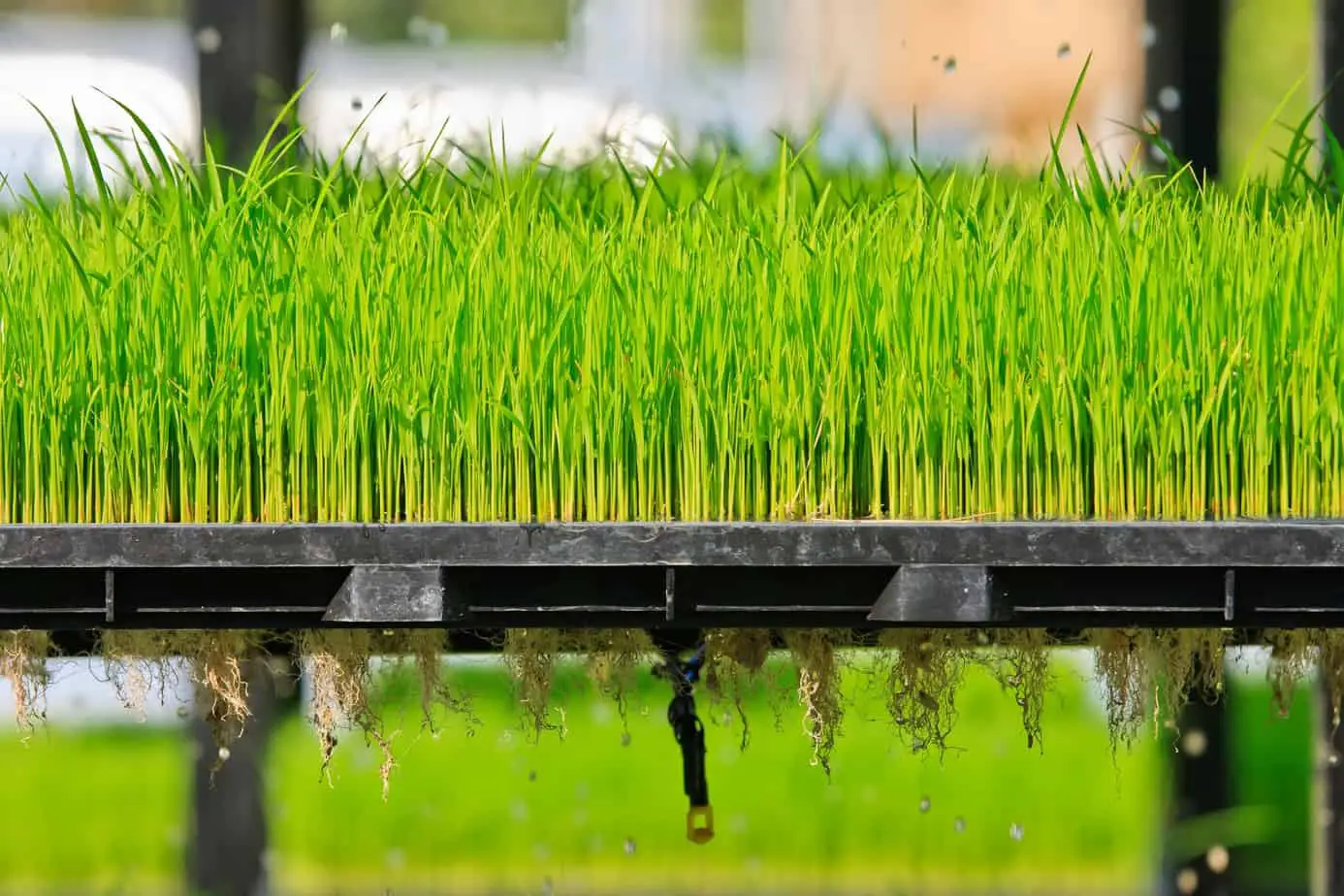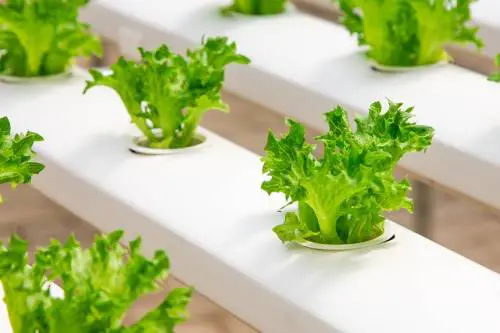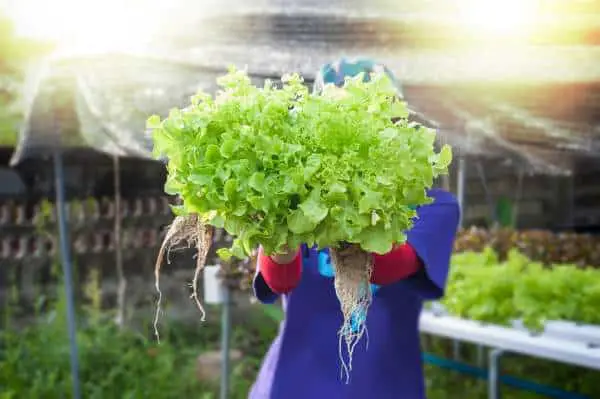New farming methods have risen among innovative gardeners, hydroponics, and aeroponics having been some of the biggest uptakes in the industry. Like many uninitiated, you’re probably wondering what each involves and what the critical differences between aeroponics and hydroponics are. Many of the differences come from the method of delivering nutrients, applications, plant growth, and growing medium (or lack thereof). It gets more confusing when you do a little research, only to find out that an aeroponic system is technically a type of hydroponics. So let’s take a look at what the difference is in regards to what people consider traditional hydroponics (ebb and flow, DWC, wick method, etc) and aeroponics.
The first big difference: Root Systems
Both hydroponics and aeroponics deal with growing plants without the traditional growing medium of soil. How the plants’ roots are situated determines how they receive nutrients (as you probably know if you know anything about plants). Just like you learned early in your first years of school, a plant’s health depends on the nutrients absorbed from the soil.
So, because the plants don’t get nutrients from the soil, the soilless hydroponics and aeroponics systems have to deliver nutrient-rich solutions in another way. That also means that gardeners have to situate the roots in a way that allows nutrient absorption. Hydroponics systems more or less have the roots of the plants submerged into water (with or without a growing medium). In aeroponic systems, the roots are exposed and sprayed with a mist containing a nutrient solution.
How hydroponic systems deliver nutrients
Hydroponics deliver nutrients via the water in which plants are absorbed. Nutrient solutions are added to the system’s water reservoir and the plants then absorb nutrients and water when the water cycle floods the roots.
How aeroponics delivers nutrients
Aeroponics, naturally, also delivers nutrients through the water given to the plants but the format is very different. Plants are grown in a humid, fog-like environment where continual or timed misting keeps the roots from drying out and supplies the nutrient solution.
Aeroponics vs. Hydroponics Setups
While it sounds like an obvious point, there are critical differences in how both of these systems need to be set up. Because the plants are receiving nutrients in different ways, care has to be taken to set the system up in a way that not only doesn’t kill the plants but encourages healthy plant growth.
Now back to the roots…
Plant positioning may look similar in some setups if you don’t know what to look for. But don’t let that fool you. Hydroponics and aeroponics systems have plants positioned and secured to keep them stable and ensure nutrient delivery isn’t wasted.
Hydroponics systems often use a type of chemically inert growing medium (so it won’t affect your nutrient-rich water). This medium helps keep plants in place and delivers a more consistent flow of both moisture and nutrients. Plants are also sometimes grown in vertical towers where plants are secured.
Aeroponic systems have to have a way of securing plants while leaving roots stable but exposed. Often special aeroponics clips are used to achieve this and allow for more movement if you need to tweak your system later on. If clips aren’t used to secure plants, usually gardeners use foam sheets or boards that they’ve modified (adding holes or slats where needed).
To really illustrate the differences between the setups of these two systems, here’s a brief look at the basics of hydroponic and aeroponic systems.
The Basics of a Hydroponic Setup
Hydroponic systems first have plants typically positioned in a growing tray. A water reservoir is kept nearby, and a fill line, tube, or wick goes from the reservoir to the grow tray. A pump located in the reservoir (if it’s a submersible pump) or connected outside of the reservoir (it it’s an inline pump) then powers water through the line and up to the grow tray. An overflow drain then returns unused water back to the reservoir or tank.
The basics of an aeroponic system
Aeroponic systems are typically set up with roots hanging down (as that’s the growing method most natural for them anyway), positioned below a board or tray that secures the plants up top. The roots are often contained in a ‘basket’ that keeps them from tangling with other plants’ roots.
Below the plants is the nutrient-rich water reservoir (although some gardeners choose a more complex setup where the reservoir is detached and water lines go across to reach plant roots). A submersible water pump is housed in the reservoir and pushes the nutrient solution through to the nozzles. Special misting nozzles are used to make sure the roots get a fine and nutrient-rich mist instead of large droplets. Then, any water run-off naturally drips back into the reservoir.
It is worth noting that because roots are never submerged, gardeners must make sure they have enough nozzles (and that they’re optimally positioned) to reach all areas of the roots.
Read more: Is Aeroponics Cost-Effective?
Water Supply and Resources Used
Both aeroponics and hydroponics are known to be more efficient and less resource-intensive than traditional soil gardening. But because they’re both such different systems, they use different amounts of resources. Some of this is because of their nutrient delivery, and some because of the need for powering cycling and maintaining the system.
Hydroponics uses greater quantities of water to produce its water cycles. However, because water is reused to a certain extent, water waste is kept to a minimum. So if a gardener cycles every couple of hours, and has 50 gallons of water go through their system, that doesn’t mean all 50 gallons are then disposed of. At the same time, it still uses more water than an aeroponic system.
Aeroponic systems rely on a fine mist of water to maintain plant roots. While some setups do have more mist spraying, and at more frequent intervals, the water usage is lower than in a hydroponic system, though it may seem counter-intuitive. You can kind of think of it as a shower (aeroponics) vs a bath (hydroponics). Aeroponics, like the shower in this example, uses less water over less time.
Hydroponics vs. Aeroponics Maintenance
A common beginner mistake when setting up their alternative growing system often only comes to light after some use, when it’s already too late to make a change.
So what is it? System maintenance.
Once you’re growing, it’s going to be one of the most critical aspects of keeping your plants healthy (and alive!). Whether you grow using hydroponics or aeroponics setup, you need to perform regular system maintenance. This includes doing water and nutrient testing as well as cleaning the components of your system such as nozzles (in the case of aeroponics), your water reservoir, changing outgrowing medium (in the case of hydroponics), and much more.
The majority of your maintenance time will be spent on different aspects of your system depending on whether you choose hydroponics or aeroponics.
In hydroponics, you’ll have to do routine water changes and top-offs. That means when the water in the reservoir becomes lower you’ll have to add in water and do larger water changes every couple of weeks. Because water evaporation causes chemicals from the nutrient-rich solution to become more concentrated, you’ll have to test the water to maintain pH and nutrient levels and ensure there isn’t too much solution in the water. Once your system is established, you can test less frequently, usually a couple of times a week. The water reservoir, or tank, will also have to be regularly cleaned. In addition, any extra equipment like pumps and water lines will have to be cleaned and inspected for damage and degradation regularly.
Aeroponic systems can have fluctuating pH levels and nutrient solutions as a result of their constant mist flow and you will have to test your solution more often as a result. While the frequency you test with will go down over time, you’ll still need to more often than in hydroponics. That means eventually you will still need to test several times a week. Especially when an aeroponic system is newer, roots need to be inspected frequently to ensure they aren’t drying out. If roots seem dry or withered, that means you’ll have to adjust the spraying cycles. Aeroponic systems also need special attention to the nozzles that supply the mist. They can frequently become clogged with scaling or mineral deposits and need to be inspected and cleaned regularly to avoid a clog that prevents roots from getting sprayed.
They’re measured differently
Well, kind of. First of all, the pumps are measured differently. If you’re looking into equipment for a home setup, you’ll quickly see a ton of different abbreviations: GPH, PSI, HP. So what does it mean and why does it matter? These units all determine how much water your pump will move through your system.
In hydroponics, pumps are typically graded in GPH, or gallons per hour. This is a measure of again, how much water will move through your system in a cycle. In some cases, hydroponic pumps are graded in HP or horsepower. Pumps that grade in HP are inline type and used more for larger systems.
Aeroponic pumps are graded in PSI units. PSI stands for, pounds per square inch, which is a unit that measures the amount of pressure exerted. Because aeroponics doesn’t ‘flow’ water through the system and instead uses pressure to produce water in mist form, using gallons per hour as a measurement wouldn’t make sense. The amount of PSI the pump can produce, in addition to the nozzle, determines the droplet size. The most common droplet size for household aeroponic systems is 30 to 80 microns.
Differences in cycling
Both aeroponic and hydroponic systems have to use a means of regulating how nutrients are provided to plants, and the biggest way this occurs is through timed cycling. So how do these different systems cycle?
Hydroponic water cycling
Hydroponic systems have water cycles that basically measure the time it takes for the grow tray to fill with water and subsequently go through a gradual draining. A typical cycling time is about 1 ½ to 2 hours, although it can vary a bit depending on the needs of the plants. The water cycle allows the plants ample time to absorb the nutrients they need, while also helping to provide the roots with oxygen thanks to the rotation of the water. When a growing medium is used, it helps retain oxygen and moisture in between cycles.
Aeroponic cycling
First, it should be said that not all aeroponic systems technically cycle. In an LPA system or low-pressure aeroponic system, sprinklers pretty much run constantly. A few smaller sprinkler heads simply spray the roots continuously. HPA systems, or high-pressure aeroponic systems, do cycle. The point of cycling in a high-pressure system is to keep the smaller droplets from forming larger droplets, which in turn make nutrient absorption more difficult for the roots. To prevent larger droplets, misting is done for 5 seconds or less, in intervals of about 5 minutes.
Other differences to consider
So, while we’ve discussed the major differences between the two, there are some other differences between traditional hydroponics and aeroponics that are worth a mention.
Level of skill involved
When asking yourself the question “Which one is better: Hydroponics or Aeroponics”, you have to understand that there is a different level of skill involved. Initial costs will vary as well, aeroponics being on the more expensive side.
While both hydroponics and aeroponics are great, eco-friendly ways to grow plants, there is something to be said about the skill level involved in either of them. Hydroponic growing offers gardeners a wide variety of systems to choose from, and many people choose to construct their own at home, or even in the classroom. These DIY hydroponic systems can be very cost-efficient and simple to assemble. After you know the basics, hydroponic gardening can be easily continued by any beginner.
Aeroponic systems require a little more technical ability and a lot more in terms of properly setting up and maintaining them. Yes, beginners can grow aeroponically regardless of their skill level, but it’s going to take more work. Because of not only the equipment, but also the need to frequently test your nutrient solution and bacterial growth, monitor your plants, and deal with any arising issue with the plants or equipment, it’s going to take some dedication. Not only that, aeroponic systems tend to be more costly, and which may cause hesitation among new growers.
The types of systems
Okay, it’s true that aeroponics is a type of hydroponics. That being said, there are still some different kinds of systems and setups you can use with each of them. Currently, traditional hydroponics offers more variety, but we’ll still take a look at the basics of some of their different system types.
Hydroponic System Types
Deep Water Culture (DWC)
In a deep water culture system, plant roots are continuously submerged. Plants are typically placed on a board or tray that allows roots to hang beneath. The root is held in netted pots (typically also containing a growing medium) and hung directly into the nutrient solution. These systems are simple, but they do need an airstone in the reservoir to ensure plants don’t ‘drown’ without proper oxygenation.
Nutrient Film Technique (NFT)
In NFT systems, like DWC systems, the roots are constantly in the nutrient solution. However in NFT systems, the roots aren’t entirely submerged. They sit in and just above the growing channel, where nutrients are pumped and then flow across the channel because of a slight slope. Run off water goes back into the reservoir for reuse.
Wick
Wick systems are one of the simplest kinds of hydroponic systems, and can even be used with or without a pump. Plants are arranged in a tray with growing medium, and situated directly above the nutrient solution. Then, a wick (typically made of a fiber that can absorb a lot of liquid) connects from the nutrient solution up to the growing medium. The growing mediums used need to be absorbent enough to work, so vermiculite and perlite are popular choices.
Drip
Drip systems employ a similar set up to many of the other systems, but in this case plants are given nutrients through a drip line. The plants are still placed in the growing medium, but a drip line typically goes to each individual plant. Run off can either be ‘recovered’ (aka reused) or ‘non recovered’ (aka disposed of).
Aeroponic system types
Traditional aeroponic system
While aeroponics is an increasingly popular form of hydroponics, there’s still a typical setup that comes to mind with aeroponics. Plants are suspended to expose the roots while special nozzles spray intermittently using a very short burst. Droplets are generally in the size range of 30 to 80 microns.
Fogponic systems
Fogponics is a new take on aeroponics, although it’s set up in a very similar manner. In this case, however, more specialized nozzles are required and may be positioned differently as fogponics also targets leaf nodes and stems. In these systems, the nutrient solution is delivered as a vapor that reaches more areas of the plants. How? Basically, the droplets produced are so tiny (5 to 30 micrometers) that they qualify as vapor.





